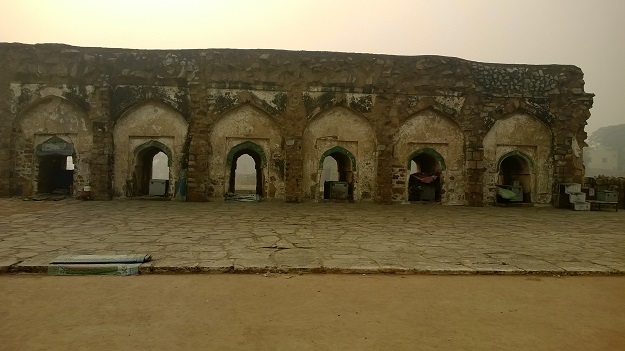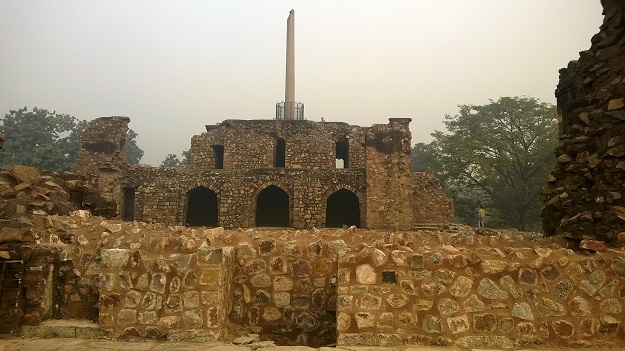Another winter morning. Another walk with our dear Sohail Hashmi with his mix of professor and grandfather tales. We are addicted for sure. This walk, especially, held a lot of promise. The stories that we had heard in Old Delhi about it and William Darlymple’s book had built too much expectations and we just could not wait to meet the famed djinns that inhabited the ruins.
Everyone woke up to these ruins quite lately. They were not the mighty Qutub Minar or everyone’s favourite Humayun Tomb or Purana Qila. We were surprised to hear that the fort grounds were used as a bus depot for sometime. It was also used as an open air auditorium for a considerable longer duration. The abuse had begun centuries before, though. When Shahjahanabad was built, stones were taken from the walls here as it was easier than quarrying for new ones. The cannibalization may have been standard practice. Thankfully, the main structure is intact.
The first stop was the djinn wall. The wall is black from incense soot and candle fire. They land in droves on Thursdays, the supplicants, some with wishes in their hearts, most others carry letters instead. More about that later. No one knows how old or true the djinns are. In fact, the lore had died down. It was in the early nineties that someone somewhere twisted a plug and the place started to top the desperate folk’s chart all over again.
However, like a temporal vortex the place becomes sacred only on Thursdays. Rest of the days, you won’t even notice anything otherworldly. The same gardens, the same ruins. There is a stepwell here too, supposedly quite good. But the caretaker was on leave. So, it stayed locked. Thank goodness, I hadn’t come all the way from Netherlands or I would have sat on a fast until it was opened. We just moved on to come back another time.
The grounds are not as large as Humayun Tomb or the Purana Qila. There are the living quarters, a masjid, some cellars at the ground level and you are done. However, the most important sight in the fortified area is the Ashoka Pillar that was erected on top of the three tiered residential quarters in the heart of the grounds. The 13.1 meter pillar was so heavy that it cracked the roof that first time it was mounted. Later, the roof was reinforced and the pillar was erected. The pillar dates back to 3rd century BC. But you can see it intact and shining till date. Is it the sandstone or did they polish it with some magic sunscreen, god only knows.
As you come down from the pillar, you can see the rest of the structure. Few of the fellow walkers narrated stories about being harassed by babas etc. Some others have seen babas offer prayers etc. The djinns are not exactly givers of dark power, like Kali in Hinduism, but try telling that to the seekers. The dark forces apart, most of the people who turn up are looking for fixes in life – from relationships to daughter’s marriage etc. How do we know? We took the liberty of reading a few letters. I heard there is a guy who is doing his PhD on these letters.
The mosque is now an open one. Once upon a time it had a massive and impressive dome. Most probably, it may have collapsed from sheer neglect as no one inhabited this city for too long. You can see the remnant walls, parts of which have been painted the gaudy green by the new Islamists. It’s amazing how that horrible shade of green has started to cover all new masjids and why the hell are they painting the old ones over. None of the older Islamic structures wore than horrible fluorescent colour, I don’t know what the new madness is about.








